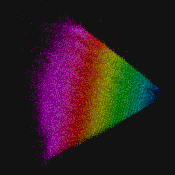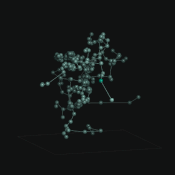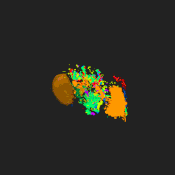
Research
Security News
Threat Actor Exposes Playbook for Exploiting npm to Build Blockchain-Powered Botnets
A threat actor's playbook for exploiting the npm ecosystem was exposed on the dark web, detailing how to build a blockchain-powered botnet.
lore-engine
Advanced tools

If you use this code or application, please cite the original paper published by Bioinformatics: 10.1093/bioinformatics/btx760
Current Version: 1.0.27 (Godzilla)
 |  |  |  |
Browsing the SureChEMBL database (containing > 12 million datapoints): Faerun.
A basic fiddle See the examples folder for more details.
You can either download or clone this repository and use the JavaScript file in the dist folder, or you can use yarn to install the package lore-engine:
yarn add lore-engine
If you decide not to use the ready-to-go scripts in dist, you can (edit and) build the project by running:
npm install
gulp
A simple example can be found in the example folder. The example data file was downloaded from the website of the Berkeley Drosophila Transcription Network Project. It is a very small data set (N=6000) chosen because of the small file size (larger files can not be hosted on github).
| Option | Identifier | Data Type | Default Value |
|---|---|---|---|
| Antialiasing | antialiasing | boolean | true |
| Verbose Mode | verbose | boolean | false |
| The HTML element where FPS info is displayed | fpsElement | HTMLElement | document.getElementById('fps') |
| The canvas background color | clearColor | Lore.Color | Lore.Color.fromHex('#000000') |
| The distance of the camera to the center | radius | number | 500 |
| Clear Depth | clearDepth | number | 1.0 |
| Center (LookAt) | center | Lore.Vector3f | new Lore.Vector3f() |
| Enable depth test | enableDepthTest | boolean | true |
| Enable alpha blending | alphaBlending | boolean | false |
The options for the coordinate helper are self-explanatory:
{
position: new Lore.Vector3f(),
axis: {
x: {
length: 50.0,
color: Lore.Color.fromHex('#222222')
},
y: {
length: 50.0,
color: Lore.Color.fromHex('#222222')
},
z: {
length: 50.0,
color: Lore.Color.fromHex('#222222')
}
},
ticks: {
enabled: true,
x: {
count: 10,
length: 5.0,
offset: new Lore.Vector3f(),
color: Lore.Color.fromHex('#1f1f1f')
},
y: {
count: 10,
length: 5.0,
offset: new Lore.Vector3f(),
color: Lore.Color.fromHex('#1f1f1f')
},
z: {
count: 10,
length: 5.0,
offset: new Lore.Vector3f(),
color: Lore.Color.fromHex('#1f1f1f')
}
},
box: {
enabled: true,
x: {
color: Lore.Color.fromHex('#222222')
},
y: {
color: Lore.Color.fromHex('#222222')
},
z: {
color: Lore.Color.fromHex('#222222')
}
},
}
| Option | Identifier | Data Type | Default Value |
|---|---|---|---|
| Visualize the octree (for debug purposes) | visualize | boolean or string | false, 'centers', 'cubes' |
| Enable multiselect | multiSelect | boolean | true |
| Option | Identifier | Data Type | Default Value |
|---|---|---|---|
| Create an octree when setting positions | octree | boolean | true |
| The maximum number of vertices in a octree node | octreeThreshold | number | 500 |
| The maximum depth of the octree | octreeMaxDepth | number | 8 |
| Point size scaling | pointScale | number | 1.0 |
| The maximum point size | maxPointSize | number | 100.0 |
The documentation can be found in the docs folder. A markdown version is available here.
FAQs
A WebGL based 3D data visualization engine.
The npm package lore-engine receives a total of 139 weekly downloads. As such, lore-engine popularity was classified as not popular.
We found that lore-engine demonstrated a not healthy version release cadence and project activity because the last version was released a year ago. It has 1 open source maintainer collaborating on the project.
Did you know?

Socket for GitHub automatically highlights issues in each pull request and monitors the health of all your open source dependencies. Discover the contents of your packages and block harmful activity before you install or update your dependencies.

Research
Security News
A threat actor's playbook for exploiting the npm ecosystem was exposed on the dark web, detailing how to build a blockchain-powered botnet.

Security News
NVD’s backlog surpasses 20,000 CVEs as analysis slows and NIST announces new system updates to address ongoing delays.

Security News
Research
A malicious npm package disguised as a WhatsApp client is exploiting authentication flows with a remote kill switch to exfiltrate data and destroy files.